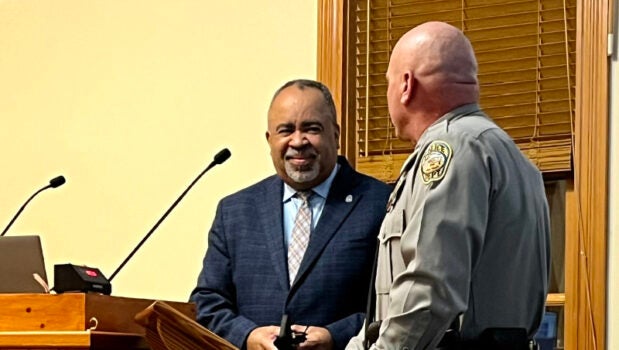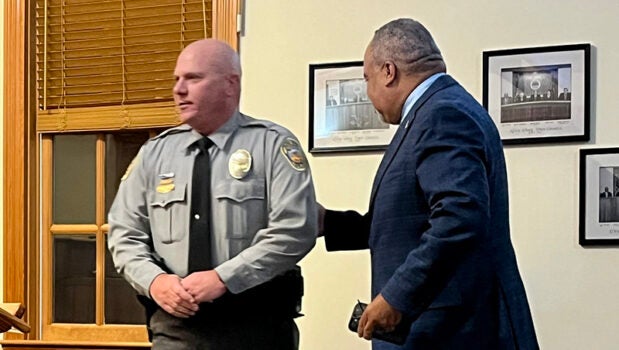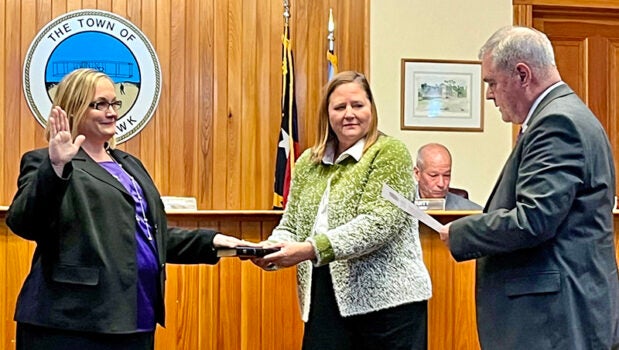Kitty Hawk Police Department honored with FBI-LEEDA Agency Trilogy award
Published 11:52 am Wednesday, January 17, 2024
|
Getting your Trinity Audio player ready...
|
Kitty Hawk’s police department was recognized and awarded by FBI-LEEDA at the Monday, January 8, 2024 monthly council meeting, and the town welcomed their new town clerk, Kristin Fellenstein. The council was also given an update regarding the proposed West Village subdivision, which has served as a major topic of discussion at prior meetings.
The executive director of FBI-LEEDA, Jacques Battiste, presented the FBI-LEEDA Agency Trilogy award to the Kitty Hawk Police Department and congratulated them on this “new milestone of excellence.” This 501c3 corporation aims to advance law enforcement leadership and promote learning to spark growth within law enforcement management practices through training, education and networking among police professionals throughout the United States and beyond. Kitty Hawk’s police department became the third department in the state of North Carolina to have all of their officers complete all three FBI-LEEDA flagship courses. There were only 49 agencies across the country to receive this award in 2023.
“I can’t tell you how much I appreciate you coming down here and how honored we are,” Chief Michael Palkovics said to Battiste. He shared that this the FBI-LEEDA training is “premier” and “one of the best trainings you can get as a police officer.” Palkovics stated that the department is committed to maintaining this status and ensuring that all their officers receive this training moving forward. “This [training] improves us at our jobs and improves us as people.”
Former town clerk Lynn Morris had retired toward the end of 2023, leaving a vacancy within the administration staff. That position has since been filled by Kristin Fellenstein. She took her oath of office at Monday’s meeting. The new town clerk and public information officer served as the executive director of the Virginias Chapter for the Club Management Association of America, and had been working with elected boards for numerous years. She also worked with Hermitage Country Club, Willow Oaks Country Club and Boy Scouts of America. Fellenstein holds a master’s degree in public administration and a bachelor’s degree in political science and criminal justice from Barton College. Town staff was excited to have to her join their leadership team.
Town attorney Casey Varnell stepped in for the town’s planner to update the council on a proposal that had raised concerns among the community. At a town planning board meeting back on November 16, 2023, an applicant came forward to propose a 27-lot subdivision off of West Kitty Hawk Road. In discussing whether to approve or deny the proposal, the planning board considered a recently adopted text amendment regarding minimum lot size calculation in regard to wetlands and uplands. At that time, vice chair of the planning board Bryan Parker was under the impression that the amendment meant approval could come in the case of 15,000 ft. of contiguous uplands, not uplands that were separated by wetlands as the plat suggested.
This confusion in terms of the intent of the text amendment as opposed to the language itself led the council to seek further information while considering the subdivision proposal.
As per the request of councilman David Hines, a traffic study was conducted within the vicinity of West Kitty Hawk Road. North Carolina’s Department of Transportation (NCDOT) reported that traffic issues “are not anticipated for this development,” and suggested a sight triangle be delineated on the plat for the road. The police department deployed its trailer during the week of December 8, 2023 through December 16, 2023 and reported that there were 5,904 vehicle commutes on West Kitty Hawk Road; this was going one way.
The town planner noted in his report that traffic impact is not a factor included in either zoning or subdivision ordinances; sole determination to be made regarding traffic is whether the proposed road is appropriate for the number of lots being created. he stated that the “proposed road is less than 2,500 feet in length and would not collect traffic from more than 100 dwelling units, therefore … it classifies as a ‘local residential subdivision street.’”
It was also reported that a school bus would not be sent down the cul-de-sac until 10 or more bus riders lived on the roadway. Public commenters at previous meetings had expressed concerns over both traffic impacts and safety, which is why they were addressed in the update.
Varnell shared that the town engineer was in need of additional information from the applicant, and therefore, the council would wait until the information was received before having the proposal come back before them for deliberation. He then referred to council meetings which had taken place back in 2013 through 2015, where prior proposals for this site were up for debate. The town planner noted in his report that in the December 2, 2013 town council meeting minutes, the council acknowledged that despite concerns raised by three public comments, if the proposal was consistent with the ordinance, it must be approved, regardless of how they felt about the proposal. This is when a proposal was reviews for 30 lots of 22 acres in this vicinity.
At another council meeting on June 2, 2014, no public comments were heard regarding a revised proposal of the subdivision, which included 29 lots on 22 acres. The majority of the council at that time felt as though the proposed density of 1.32 dwellings per acre was “too intense,” despite meeting the maximum density requirements set forth by the VR-1 district (two dwellings per acre). The planner reiterated that in an administrative subdivision review, “general feelings do not matter, the only thing council can base a decision on is whether the proposal is compliant with Chapters 38 and 42 of the town code.”
The planner’s report noted that during the meeting back in 2014, it was discussed by the planner at that time that there was no statement in the subdivision ordinance that would require upland to be contiguous, which is still the case today. He went on to confirm that the only things council can consider when making a decision on subdivisions are whether the proposal is consistent with regulations in the town code under Chapter 38: Subdivisions and Chapter 42: Zoning.
“The bottom line is that if the intent of the most recent minimum lot size wetland ordinance by this council is determined to require it to be contiguous, and that’s the consensus or majority, then the council can vote in that manner,” said Varnell. He then pointed out that if the basis of denial is that the proposal does not meet the intent of the text amendment in that it does not comply with the ordinance, then that is something the council can vote on. “However,” Varnell added, “I do recall the applicant saying that they could redesign the road and form the subdivision with the same amount of lots to meet the ordinance, but that would require destruction of more vegetation and the filling of more wetlands.”
Hines confirmed with Palkovics that the traffic study suggested a relatively low traffic impact and reaffirmed with Varnell that regardless of how the ordinance is perceived, the applicant could come back with a redesigned proposal which would have bigger impacts on wetlands and infrastructure. Mayor Pro Tem Jeff Pruitt addressed the confusion in regard to the newly adopted text amendment and said he would like to see the applicant go back to the town planner to resubmit a proposed text amendment with language “as I think they intended.” Pruitt mentioned that the council does have the authority to propose new text amendments, so it would be up to the applicant to reword with their original intention. “I think that’s a good place for us to start on that.” Council members were all in agreement to give direction to that effect to the applicant and town planner.
SUBSCRIBE TO THE COASTLAND TIMES TODAY!









